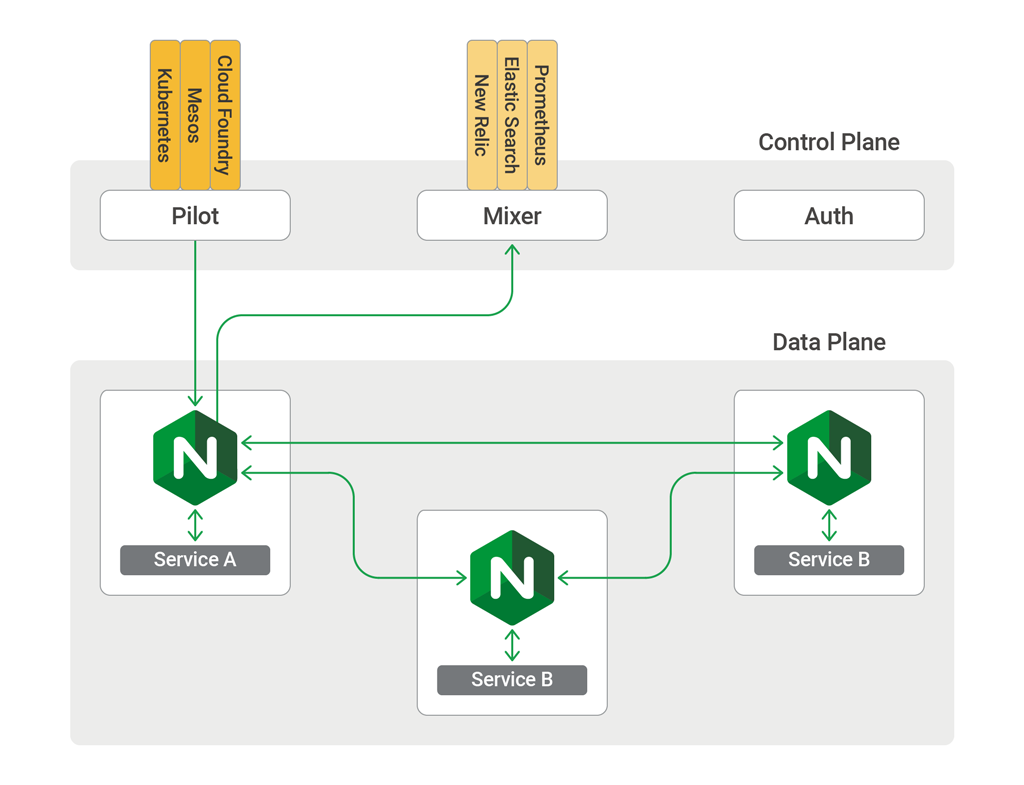
What is a Service Mesh?

A service mesh is a configurable infrastructure layer for a microservices application. It makes communication among service instances flexible, reliable, and fast. The mesh provides service discovery, load balancing, encryption, authentication and authorization, support for the circuit breaker pattern, and other capabilities.
The service mesh is usually implemented by providing a proxy instance, called a sidecar, for each service instance. Sidecars handle communications within the app.
Istio, backed by Google, IBM, and Lyft, is currently the best‑known service mesh architecture. Kubernetes, which was originally designed by Google, is currently the only container orchestration framework supported by Istio.
Service mesh comes with its own terminology for component services and functions:
- Container orchestration framework. As more and more containers are added to an application’s infrastructure, a separate tool for monitoring and managing the set of containers – a container orchestration framework – becomes essential. Kubernetes seems to have cornered this market, with even its main competitors, Docker Storm and Mesosphere DC/OS, offering an integration with it.
- Services vs. service instances. To be precise, what developers create is not a service, but a service definition or service instance template. The app creates service instances from these, and the instances do the actual work.
- Sidecar proxy. A sidecar proxy is a proxy instance that’s dedicated to a specific service instance. It communicates with other sidecar proxies and is managed by the orchestration framework.
- Service discovery. When an instance needs to interact with a different service, it needs to find – discover – a healthy, available instance of the other service. The service mesh keeps a list, for all services, of the instances that are ready to receive requests.
- Load balancing. In a service mesh, load balancing works from the bottom up. The list of available instances maintained by the service mesh is stack-ranked to put the most available instances – that’s the load balancing part – at the top.
- Encryption. The service mesh can encrypt and decrypt requests and responses, removing that burden from each of the services. The service mesh also improves performance by prioritizing the re-use of existing, persistent connections, reducing the need for the computationally expensive creation of new ones.
- Authentication and authorization. The service mesh can authorize and authenticate requests made from both outside and within the app, sending only validated requests to service instances.
- Support for the circuit breaker pattern. The service mesh can support the circuit breaker pattern, which isolates unhealthy instances, then gradually brings them back into the healthy instance pool if warranted.
The service mesh itself – service instances, sidecar proxies, and the interaction between them – is called the data plane of a service mesh application. (Though it’s not included in the name, the data plane handles processing too.) But a service mesh application also includes a monitoring and management layer, called the control plane.
The control plane handles tasks such as creating new instances, terminating unhealthy or unneeded instances, monitoring, integrating monitoring and management, and gracefully shutting down the app as a whole. The control plane typically includes, or is designed to connect to, an application programming interface, a command-line interface, and a graphical user interface for the app.

NGINX has an Istio‑compatible service mesh called nginMesh. This diagram of the nginMesh architecture shows NGINX in the sidecar proxy role, along with typical Istio components.
A common use case for service mesh architecture is when you are using containers and microservices to solve very demanding application development problems. Pioneers in microservices include companies like Lyft, Netflix, and Twitter, which each provide robust services to millions of users worldwide, hour in and hour out. For less demanding application needs, simpler architectures are likely to suffice.
Service mesh architectures are not ever likely to be the answer to all application development problems. Architects and developers have a great many tools, only one of which is a hammer, and must address a great many types of problems, only one of which is a nail.
All of the elements that come together in a service mesh architecture can be, and are, used productively outside of it. These include NGINX, containers, Kubernetes, and microservices architectures that don’t use a service mesh. Even Istio, which is a complete service mesh architecture, is designed to be modular, so developers can, if they choose, select only the parts of it that best serve their purposes, rather than adopting all of it together. With this in mind, it’s worth developing a solid understanding of service mesh concepts, even if you’re not sure if and when you’ll fully implement a service mesh application.
This blog post will be the first in a series. Currently, our planned posts include:
- What Is a Service Mesh? This post.
- Advantages and Disadvantages of a Service Mesh Architecture. Describes when service mesh is the right answer, and when alternatives might be better.
- Service Mesh vs. API Gateway. Shows when an API gateway might solve most of your problems, when to go straight to service mesh, and when to use a blended approach.
- Kubernetes and Service Mesh Architectures. Describes how to use Kubernetes with a variety of architectures, including service mesh.
- Using NGINX in a Service Mesh Architecture. NGINX can serve several of the key roles in a service mesh architecture – as the sidecar proxy or Ingress controller (or both), and providing features such as load balancing, service discovery, caching, and more.
The post What is a Service Mesh? appeared first on NGINX.
Source: What is a Service Mesh?




Leave a Reply